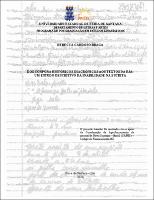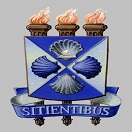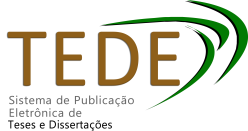| Compartilhamento |


|
Use este identificador para citar ou linkar para este item:
http://tede2.uefs.br:8080/handle/tede/1796Registro completo de metadados
| Campo DC | Valor | Idioma |
|---|---|---|
| dc.creator | Braga, Rebecca Cardoso | - |
| dc.creator.Lattes | http://lattes.cnpq.br/3106389990558611 | por |
| dc.contributor.advisor1 | Santiago, Huda da Silva | - |
| dc.contributor.advisor1Lattes | http://lattes.cnpq.br/4291233235316624 | por |
| dc.date.accessioned | 2025-05-13T16:50:10Z | - |
| dc.date.issued | 2024-09-03 | - |
| dc.identifier.citation | BRAGA, Rebecca Cardoso. Dos corpora históricos-diacrônicos aos textos da EJA: um estudo descritivo da inabilidade na escrita, 2024, 123 f., Dissertação (mestrado) - Programa de Pós-Graduação em Estudos Linguísticos, Universidade Estadual de Feira de Santana, Feira de Santana. | por |
| dc.identifier.uri | http://tede2.uefs.br:8080/handle/tede/1796 | - |
| dc.description.resumo | Nesta dissertação, realiza-se o estudo das marcas de inabilidade em manuscritos do século XXI, textos produzidos por alunos da Educação de Jovens e Adultos, comparando-os com textos escritos por mãos inábeis dos séculos XVII, XVIII, XIX e XX. O desenvolvimento deste trabalho se dá a partir da agenda constituída e adotada pelo Corpus Eletrônico de Documentos Históricos do Sertão (CE-DOHS-UEFS), e, mais especificamente, pelo projeto Documentos produzidos por “mãos inábeis”: estudos linguísticos e filológicos (CONSEPE 083/2020). Para isso, foi realizada a constituição do corpus, 27 textos escritos por indivíduos marcados por um processo de escolarização entrecortado e oriundos de segmentos sociais excluídos historicamente, a fim de responder se as marcas de inabilidade presentes nos textos escritos dos nossos estudantes de hoje já estavam presentes nos textos do passado? E se esses escreventes refletem em sua escrita as dimensões de inabilidade? Para esse corpus, Escritas da EJA, documentos inéditos, propõe-se a análise: a) da dificuldade em representar a escrita de sílabas complexas com /r/, /l/ e /s/; b) da contextualização do perfil sociocultural dos estudantes; c) da caracterização das mãos no contínuo de inabilidade; d) do estudo comparativo com corpora de épocas anteriores: XVII (Marquilhas, 2000); XVIII (Barbosa, 1999); XIX (Oliveira, 2005); XX (Santiago, 2019). Considerando a produção de textos escolares contemporâneos, se, por um lado, colabora-se com a tarefa de propiciar um melhor tratamento metodológico ao processo de constituição de corpora, minimizando os desafios enfrentados pelo pesquisador em Sociolinguística Histórica, por outro lado, colabora-se para um melhor refinamento do trabalho de ensino-aprendizagem da escrita para jovens, adultos e idosos. Conclui-se que os desvios ortográficos analisados neste estudo se espelham em registros de mãos inábeis dos séculos passados, como nos casos de grafias semelhantes e representadas em diferentes séculos, como perta por preta (XVII e XXI), perçizo por preciso e agardeci por agradeci (XVIII e XXI), memo por mesmo e gotu por gosto (XIX e XXI), civirso por serviço e severnte por servente (XX e XXI). No cotejo dos dados, foi concluído, também, que há mais mãos situadas no grau de inabilidade parcial, seguidas da inabilidade máxima, e menos com inabilidade mínima. | por |
| dc.description.abstract | This dissertation peforms the study of signs of inability in manuscripts from the 21st century, texts produced by students in Youth and Adult Education, comparing them with texts written by inept hands from the 17th, 18th, 19th, and 20th centuries. The development of this work will be based on the agenda established and adopted by the Electronic Corpus of Historical Documents of the Sertão (CE-DOHS-UEFS), specifically the project Documents produced by "inept hands": linguistic and philological studies (CONSEPE 083/2020). To achieve this, a corpus was compiled consisting of 27 spontaneoustextsfrom individuals marked by interrupted educational processes and originating from historically excluded social segments, in order to answer whether the marks: if the marks of inability present in the written texts of our students today were already present in the texts of the past? And if these writers reflect in their writing the dimensions of inability? For this corpus, Escritas da EJA, unpublished documents, we propose the analysis: a) of the difficulty in representing the writing of complex syllables with /r/, /l/ and /s/; b) of the contextualization of the sociocultural profile of the students; c) of the characterization of the hands in the continuum of inability; d) of the comparative study with corpora from previous eras: XVII (Marquilhas, 2000); XVIII (Barbosa, 1999); XIX (Oliveira, 2005); XX (Santiago, 2019). Considering the production of contemporary school texts, if, on the one hand, it contributes to the task of providing a better methodological treatment to the process of constituting corpora, minimizing the challenges faced by researchers in Historical Sociolinguistics, on the other hand, it contributes to a better refinement of the work of teaching and learning writing for young people, adults and the elderly. It is concluded that the orthographic deviations analyzed in this study are reflected in records of inept hands from past centuries, as in the cases of similar spellings and represented in different centuries, such as perta for preta (17th and 21st century), perçizo for preciso and agardeci for agradeci (18th and 21st century), memo for mesmo and gotu for gosto (19th and 21st century), civirso for serviço and severnte for servente (20th and 21st century). In comparing the data, it was also concluded that there are more hands situated in the degree of partial inability, followed by maximum inability, and fewer with minimum inability. | eng |
| dc.description.provenance | Submitted by Daniela Costa (dmscosta@uefs.br) on 2025-05-13T16:50:10Z No. of bitstreams: 1 Dissertacao_REBECCA CARDOSO BRAGA.pdf: 12293093 bytes, checksum: f9062e84e6f66d49865e3b5ef5d6ce0b (MD5) | eng |
| dc.description.provenance | Made available in DSpace on 2025-05-13T16:50:10Z (GMT). No. of bitstreams: 1 Dissertacao_REBECCA CARDOSO BRAGA.pdf: 12293093 bytes, checksum: f9062e84e6f66d49865e3b5ef5d6ce0b (MD5) Previous issue date: 2024-09-03 | eng |
| dc.description.sponsorship | Coordenação de Aperfeiçoamento de Pessoal de Nível Superior - CAPES | por |
| dc.format | application/pdf | * |
| dc.thumbnail.url | http://tede2.uefs.br:8080/retrieve/7533/Dissertacao_REBECCA%20CARDOSO%20BRAGA.pdf.jpg | * |
| dc.language | por | por |
| dc.publisher | Universidade Estadual de Feira de Santana | por |
| dc.publisher.department | DEPARTAMENTO DE LETRAS E ARTES | por |
| dc.publisher.country | Brasil | por |
| dc.publisher.initials | UEFS | por |
| dc.publisher.program | Programa de Pós-Graduação em Estudos Linguísticos | por |
| dc.rights | Acesso Aberto | por |
| dc.subject | Sociolinguística Histórica | por |
| dc.subject | Corpora Histórico-diacrônicos | por |
| dc.subject | EJA | por |
| dc.subject | Inabilidade | por |
| dc.subject | Historical Sociolinguistics | eng |
| dc.subject | Historical-diachronic corpora | eng |
| dc.subject | EJA | eng |
| dc.subject | Disability | eng |
| dc.subject.cnpq | LINGUISTICA, LETRAS E ARTES::LINGUISTICA | por |
| dc.title | Dos corpora históricos-diacrônicos aos textos da EJA: um estudo descritivo da inabilidade na escrita | por |
| dc.type | Dissertação | por |
| Aparece nas coleções: | Coleção UEFS | |
Arquivos associados a este item:
| Arquivo | Descrição | Tamanho | Formato | |
|---|---|---|---|---|
| Dissertacao_REBECCA CARDOSO BRAGA.pdf | Braga, Rebeca Cardoso - Dissertação | 12 MB | Adobe PDF |  Baixar/Abrir Pré-Visualizar |
Os itens no repositório estão protegidos por copyright, com todos os direitos reservados, salvo quando é indicado o contrário.




